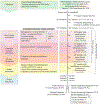The Clinical Variant Analysis Tool: Analyzing the evidence supporting reported genomic variation in clinical practice
- PMID: 35442193
- PMCID: PMC9363005
- DOI: 10.1016/j.gim.2022.03.013
The Clinical Variant Analysis Tool: Analyzing the evidence supporting reported genomic variation in clinical practice
Abstract
Purpose: Genomic test results, regardless of laboratory variant classification, require clinical practitioners to judge the applicability of a variant for medical decisions. Teaching and standardizing clinical interpretation of genomic variation calls for a methodology or tool.
Methods: To generate such a tool, we distilled the Clinical Genome Resource framework of causality and the American College of Medical Genetics/Association of Molecular Pathology and Quest Diagnostic Laboratory scoring of variant deleteriousness into the Clinical Variant Analysis Tool (CVAT). Applying this to 289 clinical exome reports, we compared the performance of junior practitioners with that of experienced medical geneticists and assessed the utility of reported variants.
Results: CVAT enabled performance comparable to that of experienced medical geneticists. In total, 124 of 289 (42.9%) exome reports and 146 of 382 (38.2%) reported variants supported a diagnosis. Overall, 10.5% (1 pathogenic [P] or likely pathogenic [LP] variant and 39 variants of uncertain significance [VUS]) of variants were reported in genes without established disease association; 20.2% (23 P/LP and 54 VUS) were in genes without sufficient phenotypic concordance; 7.3% (15 P/LP and 13 VUS) conflicted with the known molecular disease mechanism; and 24% (91 VUS) had insufficient evidence for deleteriousness.
Conclusion: Implementation of CVAT standardized clinical interpretation of genomic variation and emphasized the need for collaborative and transparent reporting of genomic variation.
Keywords: Exome sequencing; Genomic medicine; Precision medicine; Variant classification; Variant interpretation.
Copyright © 2022 American College of Medical Genetics and Genomics. Published by Elsevier Inc. All rights reserved.
Conflict of interest statement
Conflict of Interest Julius O.B. Jacobsen and Damian Smedley are paid consultants to Congenica Ltd. All other authors declare no conflicts of interest.
Figures



References
-
- Richards S, Aziz N, Bale S, et al. Standards and guidelines for the interpretation of sequence variants: a joint consensus recommendation of the American College of Medical Genetics and Genomics and the Association forMolecular Pathology. Genet Med. 2015;17(5):405–424. 10.1038/gim.2015.30. - DOI - PMC - PubMed
-
- Ellard S, Baple EL, Callaway A, et al. ACGS Best Practice Guidelines for Variant Classification in Rare Disease 2020. Association for Clinical Genomic Science. Published 2020. https://www.acgs.uk.com/media/11631/uk-practice-guidelines-for-variant-c.... Accessed March 10, 2021.
-
- Rivera-Muñoz EA, Milko LV, Harrison SM, et al. ClinGen Variant Curation Expert Panel experiences and standardized processes for disease and gene-level specification of the ACMG/AMP guidelines for sequence variant interpretation. Hum Mutat. 2018;39(11):1614–1622. 10.1002/humu.23645. - DOI - PMC - PubMed
Publication types
MeSH terms
Grants and funding
LinkOut - more resources
Full Text Sources
Medical
Research Materials

